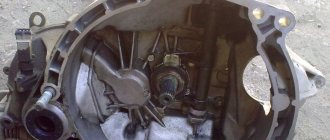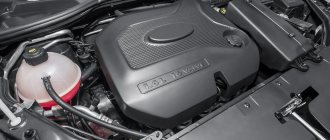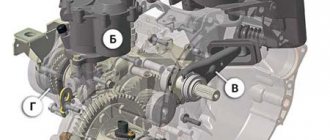5/5 — (2 votes)
On November 25, 2022, AvtoVAZ presented the updated Lada Vesta with a Jatco CVT and a Renault engine. This car will replace the version with a robotic gearbox and will cost 50 thousand rubles more than a car with a manual transmission. In addition to the new transmission, the car has acquired such innovations as a heated steering wheel, atmospheric interior lighting, electric mirrors and other pleasant little things that make trips more comfortable. But the most important thing is still technical characteristics and reliability. Actually, we will try to figure out these parameters.
What transmissions are installed on the Lada Vesta?
Until recently, the manufacturer installed a conventional “robotic” manual transmission on the car, which has one clutch.
The use of such a transmission complicated the process of driving the car several times; the gearbox took a long time to switch, and the car could stop while driving. Therefore, over time, the Lada Vesta was improved with a new stepless variator.
The Jatco JF015e transmission is a development of a Japanese concern. It is a continuously variable hybrid of a classic automatic transmission, which is complemented by a two-stage CVT.
Due to the fact that the box has 2 planetary-type gears, it became possible to reduce the size of the cones, their weight and the general parameters of the transmission.
This design has the following technical features:
- transmission type – classic with 7 gears, designated CVT-7;
- machine torque – up to 160-165 Nm;
- subject to maintenance (oil and filter replacement) every 35-40 thousand kilometers;
- lubricant volume – 7.2 l;
- the estimated resource is 160 thousand km.
As an alternative to this variator, the AMT robot can be used, which has only one clutch and is based on a VAZ-2181 manual gearbox with 5 steps.
Dynamics and fuel consumption
Acceleration of the car from 0 to 100 km/h is 12.2 seconds. The car is not very fast, but it is plenty agile for moving around the city and overtaking on the highway. Fuel consumption in the combined cycle is 7.4 liters per 100 km, and in the city the car burns about 10 liters per hundred, so it’s difficult to call it economical.
As for driving comfort, the CVT raises no complaints. Gears shift quickly and without jerking. This transmission is not new, so there are many reviews about this box, and its typical “sores” have also been identified. This is what we will talk about.
Design and principle of operation of the variator
The CVT transmission is equipped with virtual gears that are created at the program level.
The Lada Vesta transmission uses a V-belt drive, a gearbox with two stages and gears, and a torque converter. The transmission is formed by two pulleys, which are connected to each other by a V-shaped belt.
After the gear ratio is formed, it goes to the driven pulley, which is connected to the wheels and drives.
The operating principle of the variator is as follows:
- When movement begins, the cones of the driving pulleys are separated and the driven pulleys are connected. In this situation, the motor has a minimum load.
- When the speed increases, the reverse process occurs. As a result, the gear ratio decreases, which has a beneficial effect on reducing traction. In this case, the displacement of the pulleys occurs as a result of the action of springs and an increase in centrifugal force.
The variator device is represented by a mechanism responsible for transmitting torque and disconnecting the gearbox from the engine, the variator itself, a structure designed for reversing, and a control system.
The main distinguishing feature of the variator from other gearboxes is the smooth adjustment of torque within the established range.
The main structural elements of the design are pressure-reducing valves, solenoids, a hydraulic unit, a slider, a belt, a torque driver and its working elements, a bushing, a roller, etc. The hydraulic unit performs one of the main tasks - the smoothest possible transmission of force, without any stops or jerks . That is why the service life of the variator increases.
Vesta AT review
Since the new AvtoVAZ model went on sale, many potential buyers have test driven the 2022 Lada Vesta with a variator in car dealerships. Earlier, in the summer of 2022, a new automatic transmission was installed on the XRAY Cross, and even then the first videos of test drives of models with a CVT appeared on YouTube.
Externally, there are no differences between the manual Lada and the AT version. The body dimensions remain the same. The CVT transmission is larger in height than the manual transmission, but this did not affect the ground clearance, it remained the same - 178 mm, in the SV Cross version - 203 mm. Starting with the basic configuration, all models are equipped with protection that reduces the ground clearance by 3 cm.
A new automatic transmission is installed on the Lada Vesta along with a Japanese 1.6 liter engine. The power unit, which was developed by the Nissan concern, is produced at AvtoVAZ and has the factory designation H4M. Power 113 l/s with torque 156 rpm.
"Lada Vesta" automatic. Photo source: https://express-lada.ru/wp-content/uploads/2019/09/vesta-04-1.jpg
The model with the new engine, according to the manufacturers, should reach a speed of 100 km/h in 12 seconds. The declared average fuel consumption is 7.5 liters. A test drive of a Vesta with a CVT refutes the promises of AvtoVAZ. In practice, acceleration is 13.5 seconds, fuel consumption is 2.5 liters more.
Service life of the variator on Lada Vesta
The resource of the variator installed on the Lada Vesta is almost identical to this indicator inherent in the Nissan Juke, and is approximately 100 thousand km. But in order to keep this indicator normal or to achieve its increase, you should be careful about the maintenance of the part and its periodic diagnostics.
The most important thing is to promptly replace the lubricating fluid in the structure.
Car service employees recommend carrying out this procedure at least once every 45 thousand km of distance traveled. But according to the information indicated in the technical documentation, this replacement is recommended to be carried out only after traveling 120 thousand km.
The main condition is that the procedure must be complete, that is, it is necessary to carry out 3 replacements, replace the fine filter devices and rinse the coarse filter.
Also, do not forget about particles and debris that can stick to the two magnets in the tray. Another point is the liquid that is recommended for use - NS-2, NS-3.
Well, don’t forget about careful operation of the car and all its working components. To do this, you should not accelerate at the start, do not skid for a long time on areas with uneven surfaces, in mud, and in the summer heat, try not to load the variator.
Common JF015E problems
The JF015E variator is very demanding on the quality of the oil, so you need to use only transmission fluid marked NS-3.
Problems related to oil quality
If the quality of the oil is low or it is contaminated with metal shavings, which are not always completely captured by the magnets, the valve body quickly fails and jerks appear when moving. The official dealer recommends changing the oil every 60 thousand km, but in practice it is better not to drive more than 40 thousand.
The JF015E valve body has a more complex design than previous models. Its solenoids are more sensitive to the quality of the oil, so many cases of contacting a car service end with the replacement of an expensive part.
Let's continue the topic of oil. If you do not change it in a timely manner, quite pronounced scratches from metal shavings appear on the pulleys, which can result in damage to the belt, the strength of which on this transmission leaves much to be desired, or the V-belt mechanism may completely fail. At the initial stage of the problem, the cones can be ground and replaced, but if severe scuffing occurs, it is better to replace these parts. If the belt breaks, it is recommended to install a reinforced version.
Bearing failure
The most common problem that owners of cars with JF015E CVTs contact a car service center with is the destruction of the input shaft bearing. This is due to the design features of the variator - the bearing itself is quite weak, but it takes on high loads, especially if the car enthusiast prefers an aggressive driving style. The main signs of bearing failure are: gearbox noise in the “ N” and “ P” , which disappears when you start moving. If you listen, this unpleasant sound appears again at high speeds.
Similar symptoms are observed when cone bearings are destroyed, which also occurs quite often. Only “opening” the box allows differential diagnostics to be carried out.
Sun gear destruction
Another problem that can befall even owners of new cars is the destruction of the sun gear. This part is quite fragile, so car service technicians record such breakdowns even on cars with a mileage of just over 5,000 km. This kind of trouble especially often occurs with those who like to start abruptly. If the car does not move forward, but the reverse gear is working properly, then the damaged sun gear is to blame. In such cases, it is recommended to replace it with a reinforced one.
The fact is that the sun gear consists of two parts connected by welding. This connection cannot withstand heavy loads and collapses. This point can be considered a design flaw, since the problem occurs very often.
Oil pump
Another weak point is the oil pump pressure reducing valve. Its wear leads to a decrease in oil pressure, which interferes with the normal operation of the variator and leads to rapid wear of all parts. While disassembling the box, a vacuum test is carried out; if the readings are less than normal, the valve or the pump itself must be replaced. If you decide to change the valve, it is better to install a reinforced version.
The valve usually wears out when the oil is not changed in a timely manner, and scratches from metal shavings remain on it, which impairs the seal.
Another difficulty is finding the necessary spare parts. If the drive shaft bearings have failed, then this spare part is quite difficult to find. If such a problem occurs with your box, the repair may take an indefinite period.
Positive features of the Jatco variator
Many drivers are wondering which car is better to take, with an automatic transmission or a manual transmission? Unlike a hydromechanical gearbox, movement on a robot, which begins without preheating the engine at low temperatures, is smoother and more even, which has a positive effect on the operation of the transmission.
The second advantage of such an AMT compared to a traditional box is considered to be efficiency.
Such a transmission has several other advantages, the main ones of which are the affordable price, a wide variety of analog spare parts, as well as a detailed study of the design and working components of the mechanism.
The CVT really deserves a lot of praise compared to other well-known transmission options. The reason for this is a large number of justifications:
- smooth gear ratio switching, which has a beneficial effect on driving dynamics when starting or quickly accelerating;
- economical consumption of fuel mixture;
- smooth and even ride;
- no minimum speed even on sharp climbs;
- ease of maintenance due to its low weight and simple design compared to a standard automatic transmission.
Also, when changing the gear ratio, the driver will not notice unpleasant sounds in the engine operation, which usually occur with other types of transmissions.
The car owner can independently adjust the variator in order to ensure engine speed at a minimum level. As a result, the engine will operate virtually silently.
And due to the fact that the design uses a two-stage planetary gearbox, it reduces the resistance value during the process of mixing transmission oil. And this, in turn, has a beneficial effect on its performance at low temperatures, when this liquid usually thickens.
Mechanics from Renault
This is also a 5-speed manual, but from the Renault concern. The box has the index JR5 515.
It works with a 1.8 liter engine producing 122 hp. s., or as in the case of Vesta Sport with 145 horsepower. The design of the box holds torque up to 210 N*m. Structurally, this is a completely ordinary 5-speed two-shaft manual transmission, where the shift mechanism, differential and main gear are combined in one housing.
The main difference between the JR5 gearbox and its predecessor JH3, which was installed on the first batches of the Lada Vesta, is the cable shift drive and hydraulic clutch drive. The box holds more torque than the VAZ manual. Its service life is on average 250-300 thousand km.
The filling volume of the box is 2.5 liters. The original factory oil for it is ELF TRANSELF with a viscosity of 75w80. It is recommended to use this oil. As in the case of the VAZ gearbox, the automaker claims that the filled oil is designed for the entire service life. But if you do not change the oil for a long time, this can lead to increased wear on the gearbox shaft bearings and even to their destruction.
There have been cases where collapsed bearings got into the differential and led to the mechanism jamming. Therefore, to extend the service life of the unit, it is recommended to change the oil every 50 thousand km.
Advantages and disadvantages
The advantages of this transmission are the same as those of the VAZ mechanics. It is simple, reliable, repairable, has a good service life, and requires a minimum of attention and maintenance. Personally, I will highlight one minus - the Renault gearbox is expensive in terms of components compared to VAZ mechanics.
Disadvantages of the variator
In addition to the positive aspects, the variator also has negative ones:
- low strength of parts;
- the need for constant replacement of transmission fluid and filters;
- the appearance of extraneous sounds during bearing operation;
- Regular malfunctions of the planetary gear are observed.
This type of transmission also has its disadvantages, the main one of which is the specific nature of the movement. That is, on the Lada Vesta it is better to avoid slipping, rapid acceleration or sharp pressing of the brakes, as the unit can quickly fail due to accelerated wear.
It is also not recommended to drive a car with a trailer or tow another car. This is due to the fact that such driving significantly increases the load on the gearbox, increasing its wear.
Lada Vesta cars are suitable for transmissions that still have many shortcomings, but only one of them has been eliminated - a roller bearing is fixed to the input shaft.
Robot AMT
The third option is the simplest and most affordable two-pedal automatic transmission option. AvtoVAZ tried for a long time to create its own automatic machine. But there was no experience and developments in this direction. Therefore, they turned to foreign specialists from the German company ZF for help.
The result of this collaboration was the famous VAZ robot. Structurally, it is the same 5-speed manual transmission of the VAZ-2180, to which, during the modernization process, 2 actuators were added that do all the work for you: clutch and gear shift actuators.
This transmission has the VAZ-21827 index. The first robot was installed on the Lada Priora in 2014. Then it was installed on Grant. Subsequently, he reached Vesta and X-Ray. At the time of review, the robot is only available for the Lada Granta.
The first versions of the robot had an index of 21826, and there, in order for the car to start moving in “drive” mode, you had to press the gas pedal. I think this is not very convenient for an automatic transmission. Later we made a new firmware and added a “crawling” mode. That is, the car in “drive” mode began to move automatically after releasing the brake pedal. The box index became 21827.
The good thing about the robot is that it is not particularly demanding. It does not have special operating conditions that must be strictly observed in order for the unit to serve for a long time and without problems. If you compare it with a CVT, which has many “buts” and “don’ts,” then with a robot everything is really simple. It does not need to be warmed up before driving, it can be skidded, it is allowed to be towed. Dynamic driving is allowed. The oil change procedure costs only 2,500 rubles. That is, of all automatic transmissions, the robot is the simplest, most affordable and unpretentious transmission.
Pros and cons of the robot
Since it is the same VAZ 5-speed manual, it will be just as reliable, unpretentious, maintainable and inexpensive to maintain and repair. Actuators are expensive, but there are no problems with them in operation. Unless the clutch actuator with high mileage may begin to squeak. But this can be solved easily and quickly by removing, disassembling and lubricating.
Of the minuses, there were several nuances. Firstly, there were problems with the clutch discs. This manifested itself in the form of increased vibration of the transmission at the beginning of movement. The clutch disc manufacturer has modernized them several times and changed the composite composition of the friction linings. But this problem could not be completely solved.
The second negative point of the robot is that when driving in traffic jams, when there is frequent starting, the transmission may overheat. The box will go into emergency mode and the car will stop moving. It will take some time for the mechanism to cool down. Otherwise there were no problems.
How to check the variator for malfunctions?
A transmission that is in good condition and idling should not make any noise for the driver to hear the engine running. If there are extraneous noises, then the box needs servicing. This is considered the easiest way to quickly diagnose the performance of the device.
Testing the variator while driving is considered the most informative. The operation of the structure should not be accompanied by jerks when moving from a standstill. The move in this case should be smooth and even. In the future, there should also be no jerking observed during the distance, which may indicate that the belt is jamming.
To check whether the variator has been disassembled before, you need to pay attention to the condition of the bolts and fasteners. The presence of abrasions, scratches, and snags indicates that the transmission has previously been serviced with working tools. But this fact does not mean that there may be any problems with it. The main thing is to pay attention to this and ask the seller what faults have been corrected.
Don’t forget to check the level and condition of the transmission oil.
For this, a special probe is used, which is lowered into a container with liquid. The test is carried out in two states, when the oil is cold and heated, to determine its viscosity and ability to wash the working components of the variator.
conclusions
What conclusions can be drawn based on the above? Each transmission option will have its own pros and cons, strengths and weaknesses, advantages and disadvantages. Which one to choose, I think, everyone will decide for themselves.
If you are not spoiled by automatic transmissions, it’s easy for you to press the clutch and change gears yourself, and you don’t really want to bother with the nuances of operation and maintenance, then classic mechanics will be a good option for you.
If you want comfort and are willing to pay for it, then a robot or a CVT will be a good offer. In the comments, be sure to write which transmission option for the Lada Vesta is the best, and why. Share your ownership experience, write comments, ask questions.
All Lada Vesta engines. Detailed overview of available motors
When AvtoVAZ models received a variator
For the first time, a CVT transmission was installed on the X-RAY Cross. The updated crossover began to be sold at AvtoVAZ dealers in the summer of 2022. The Lada Vesta CVT model became available in November 2019. From that moment on, it became possible to purchase a Vesta SW Cross with a CVT.
"Vesta" with a variator. Photo source: https://xn--80aal0a.xn--80asehdb/auto-news/lada-vesta-news/5183-kakie-obnovlenija-poluchila-lada-vesta-s-variatorom.html
The AvtoVAZ model has become a worthy competitor to foreign cars. The improved transmission brought Vesta to the top of sales among domestic cars in the 1st quarter of 2022. A restyling is planned this year, which will bring many improvements in the appearance and interior of the car.











